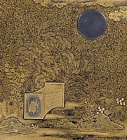Japanese Gallery (Honkan) Room 13
September 20, 2006 (Wed) - December 17, 2006 (Sun)
The 'Seven Flowers of Autumn' is a combination of plants symbolizing autumn, known to Japanese culture since the ancient times of Manyoshu (oldest Japanese poetry anthology compiled in the mid 8th century). It includes hagi (bush clover), susuki (silver grass), kuzu (arrowroot), nadeshiko (fringed pink), ominaeshi (patrinia), fujibakama (mistflower), and kikyo (Japanese bellflower). This and other autumnal plant motifs such as the chrysanthemum as well as autumnal landscapes have been popularly used in the genre of maki-e to decorate lacquer. It suggests a particular affection of the Japanese people toward this season since ancient times. Autumn not only delivers a pleasant climate, but it also is the time of harvest. The joyous appeal of autumn has been refined over time until finally being embodied in the sentimental motif of the 'Seven Flowers' that has come to decorate many lacquerwares. The liberally rendered lines of such autumnal motifs seem to carry the force of ripening life, a reflection of the exuberance of the season itself.
The chrysanthemum as a popular autumn motif has been regarded as a symbol of eternal youth both in China and Japan. The tale of the boy Kikujido, who drank dew off a chrysanthemum flower and gained immortality, grew famous through noh libretti. Based on this culture, the chrysanthemum on its own, or with streams, established itself as a representative motif of maki-e design.

